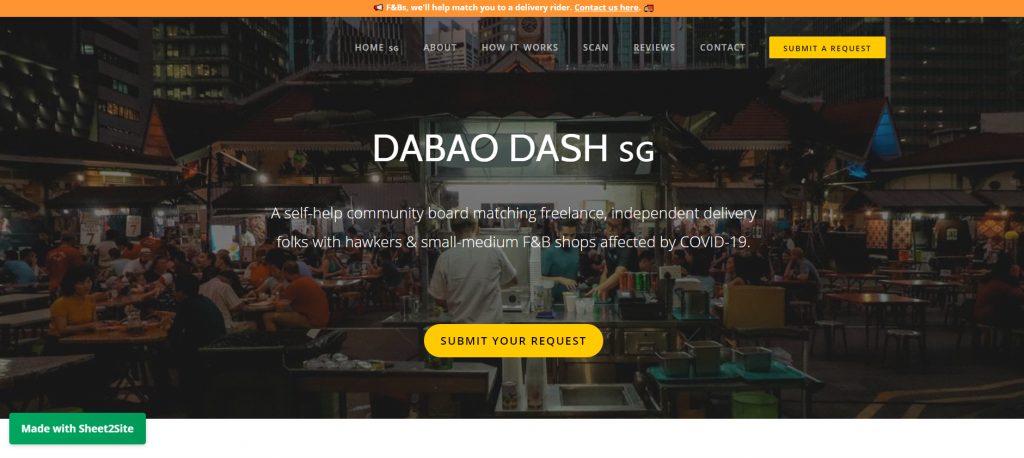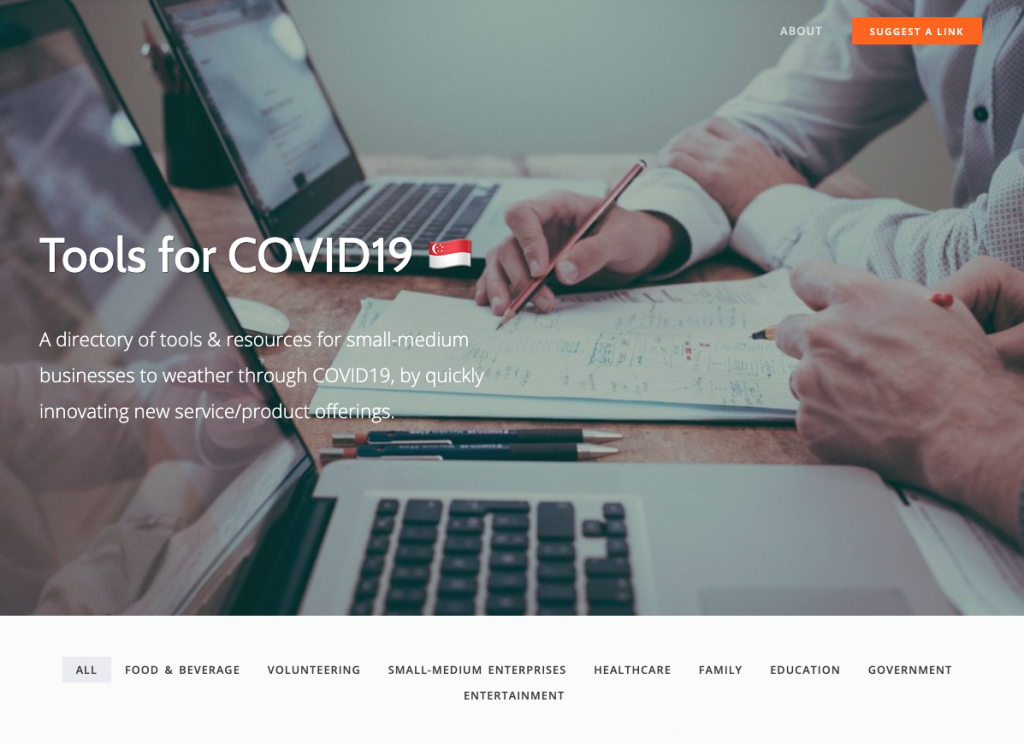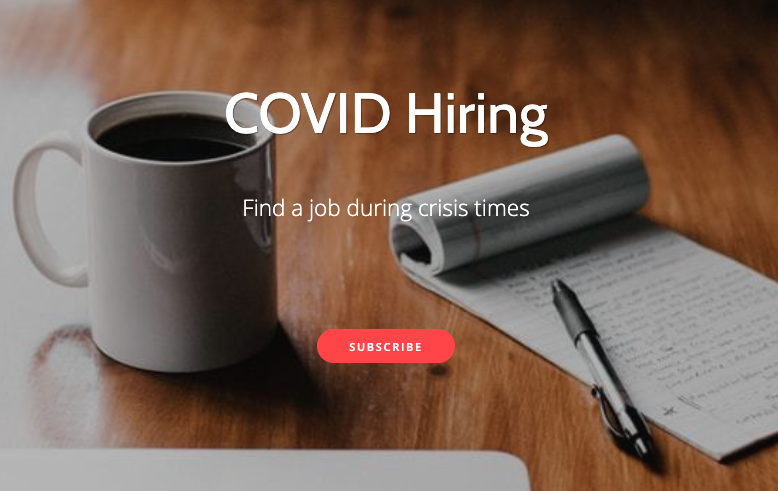Hi, I’m Jason and I started a bunch of COVID-related projects during Circuit Breaker. One of the more interesting ones was Dabao Dash.

The concept is simple. I was inspired by Mask Match – a US site matching healthcare workers needing masks with people who want to help and have masks to give. Dabao Dash is a community board matching freelance, independent delivery folks with hawkers & small-medium F&B operators affected by COVID-19. Hawkers can request for delivery, and riders can offer delivery services. This non-profit, ‘B2B’ website aims to help hawkers and small F&B operators pivot to a delivery-only business model, without the expensive middleman fees that cut into their already slim margins. An early minimum viable product is already live at https://bit.ly/dabaodash
Addressing needs of hawkers, F&Bs and delivery drivers
“Dabao” in Dabao Dash is a spin on the word for “food takeaway” that is common lingo in Singapore. With Circuit Breaker measures in place like the cessation of dine-in opportunities, our local F&B operators and hawkers are now struggling to stay afloat, many even closing down for good. I wanted to help out in any way I can. Many needed to supplement or completely switch to a delivery-only business model, but did not know where to find food delivery drivers on their own.
One big elephant in the room was: “Why not just onboard onto the big food delivery apps like Grab/ Foodpanda/ Deliveroo?” That’s exactly what they do: match delivery riders with food sellers. Why start something on our own? The issue is that being on the delivery apps cuts significantly into the already small margins of these micro-F&B owners. Typical hawker margins are slim – only ~15%, so using middleman food delivery apps with >30% commission would not work for them. Hence, many chose not to onboard to these apps, some never had the time, and others were simply not tech savvy enough to use the apps.
On the other side of the supply-demand view, delivery riders could now serve a larger pool of vendors, expanding their income sources. Customers, as well, will benefit from more food choices including from the hawkers they know and love, all while preserving the food heritage of Singapore.
Being part of emergent and overnight crazy popular Facebook groups like Hawker United and Singapore Restaurant Rescue also made me realise that even while there are now platforms for hawkers and small independent F&B operators to showcase their offerings, the food delivery driver shortage is still a big problem for getting all that good food to people’s doorsteps. I wanted to help. So I created this community board of offers and needs to match up delivery drivers with hawkers.
Inspiration for Dabao Dash
The spark of inspiration for Dabao Dash was borne out of frustration. Much of the contact information for delivery riders and hawkers needing delivery were confined to closed Facebook groups and public Google spreadsheets. This were hard to find organically via search engines. The experience of getting information in a fragmented way begged for a more consolidated, open platform. Ideally, it would be something easy to use, submit on and share. Non-tech savvy hawkers could just read off the list on Dabao Dash and call riders directly – no on-boarding needed. Submitting a request or offer was just about filling in an online form. Between delivery riders, they would just need to show the QR code to scan and not need to have another rider’s mobile to receive the link.

Speed to market with No-Code tools
As the COVID-19 situation evolves rapidly, speed-to-market via rapid development and deployment is crucial. It is literally a matter of life and death for our hawkers and F&Bs, many of whom do not have the buffer resources to tide through this.
The best thing about the process is that I built a basic version of the site in a day using Sheet2Site, a website builder that allows you to make sites using Google Sheets as a back-end database and content management system. Basically, that meant that you could update a website using a Google spreadsheet, without needing to know how to do programming!
Andrey, the founder of Sheet2site, is now offering free plans for any coronavirus-related causes, so I caught on to the opportunity with relish. He recently made a template for an offers-and-requests board which was the perfect fit for the food delivery driver match-up problem I mentioned previously. I started development on 7 Apr, and officially launched the minimum viable product on 9 Apr, all within 3 days. The use of no-code tools and technology stacks (like Sheet2Site) made this easy and possible, even for designers who do not know coding.
Intervening larger systemic forces
There are many food discovery apps and projects right now supporting local F&B operators, but not many are looking at the crucial delivery aspect of the value chain. Hence a systemic gap exists. There is also a ground swell of movements and projects to support a more de-centralised, community-driven and hyper-local approach to food delivery in F&B. The pandemic had shown how the previously centralised and middleman-dependant structure in food delivery might not be tenable in the new normal.
Our hawkers and small F&B operators are too small – many might not survive past the Circuit Breaker, let alone until COVID-19 disappears. The industry depends on being able to be disrupted towards new models. Dabao Dash hopes to be a bold experiment in a more ground-up approach to food delivery.

Impact
Dabao Dash has grown beyond what I expected. As at 24 Apr 2020, we stand at 7.5K users, 13.4K page views, and over 160 total requests/ offers listed, all within 2 weeks (launched on 9 Apr).
Anecdotally, I have heard back from some riders and hawkers about finding matches. With extra resources, perhaps there is a potential to increase impact by adding new features and services. For example, I’m contemplating a concierge service connecting suitable delivery riders to hawkers directly, ensuring a sustainable working relationship for the long term.
Growing Dabao Dash: Challenges & opportunities
It’s been almost two months since Dabao Dash was launched. It was a product made for the Circuit Breaker. With the Circuit Breaker easing off, it is also time to revisit its future. Dabao Dash had a nice head-start in growth and traffic when the gaps in matching delivery with hawkers were under-served in the early days of Circuit Breaker. But 2 months on, the traffic has definitively plateau-ed off. As at 1 Jun 2020, there are a total of 8.9K users, 16.7K page views, and slightly over 200 submissions.
One key factor that contributed to this was how Dabao Dash depended on the food-related Facebook groups for distribution initially. When stricter group posting rules were imposed for most of the groups, I was not able to share Dabao Dash as much. Referral traffic definitely took a hit as a result.
Besides that, many new local food discovery apps had also sprung up, which offered delivery match-up as well. FoodLeh and Take.sg are some notable ones which I admire. They are non-profit projects as well, and automatically match hawkers with drivers. With Dabao Dash, hawkers still have to manually call up the contact list on the site to find delivery riders. The food apps are more seamless, and therefore attractive for hawkers.
Moreover, what is interesting about Dabao Dash is how it works itself out of a job. Once hawkers know enough drivers to call regularly for delivery (by looking through the listing), they do not use Dabao Dash anymore (or any other app)! That’s not necessarily a bad thing. I like that it can empower hawkers to be self-sufficient, not depending on any apps to arbitrage their business for them. Apps can come and go, but relationships and familiarity built up from your own network of delivery drivers have much longer staying power.
Dabao Dash is now in a bit of a transitional phase. An existential one, even. Has it outlived its purpose for Circuit Breaker? Or can it still play a role in helping hawkers succeed in this new, digital normal of a post-COVID Singapore? There are a few things I’m experimenting with right now, which I could do with some help from the tech for good community (*hint hint*):
- Automation. Manual ‘concierge’ matching of hawkers with drivers, when hawkers post on the site, or when they request for delivery on any of the Facebook groups. Are there more automated ways to do this, as it’s time consuming and easy to miss? Perhaps developers can help me automate this.
- Distribution and marketing. I had been cold emailing F&Bs about tapping on Dabao Dash. But again, the challenge is that it’s time-consuming, and I’m running this by myself. Are there ways to better market Dabao Dash – including buying targeted Facebook/ Google ads? I think social media marketing and growth hacking folks could help me out here.
- Finding a new niche segment. There might be value in targeting a segment of F&B operators who might still benefit from Dabao Dash, especially those who wish to be independent and not rely on any middleman app (free/paid), wanting to maintain their own delivery network. How do I find/reach them? Maybe F&B insiders with connections can provide advice or connections here.
- Pivoting Dabao Dash to something else that can offer value. I’m all ears for this, for anyone who has ideas. It’s a useful resource, and a good directory of drivers available by region. How can Dabao Dash differentiate itself from the other food apps, find a different need to address, and stay relevant?
What will Dabao Dash 2.0 look like?
Looking back on Circuit Breaker
In April, when Circuit Breaker measures were at its peak, I decided to go where my attention seems to be drawn to most, COVID-19. I wanted to address it directly by making tech for good products with abandon. Looking back, it’s crazy how productive the month had been. If I included the work I did in March, that’s altogether 7 products* I worked on in just slightly over a month! I went from being bored to swamped, but in a good way.
I also realised how I tend to create my way out of a crisis, as a way of coping and seeking some form of control over the situation. All that energy being stuck at home also found a good outlet by contributing to helping the situation in any way I can. Along the way, I also found many kindred spirits in Better.sg, joined by a common hunger to use tech for good.
Circuit Breaker might have been tough, but it sure had been fulfilling and satisfying as well!
Editor’s Note:
For those who want to find out more about what Jason has done during this period, here’s a list of the projects that he has started and/or contributed to:
He is also offering free portfolio websites to help creative professionals build their first portfolios in these testing times, and continuing to build free websites for COVID-related causes.















